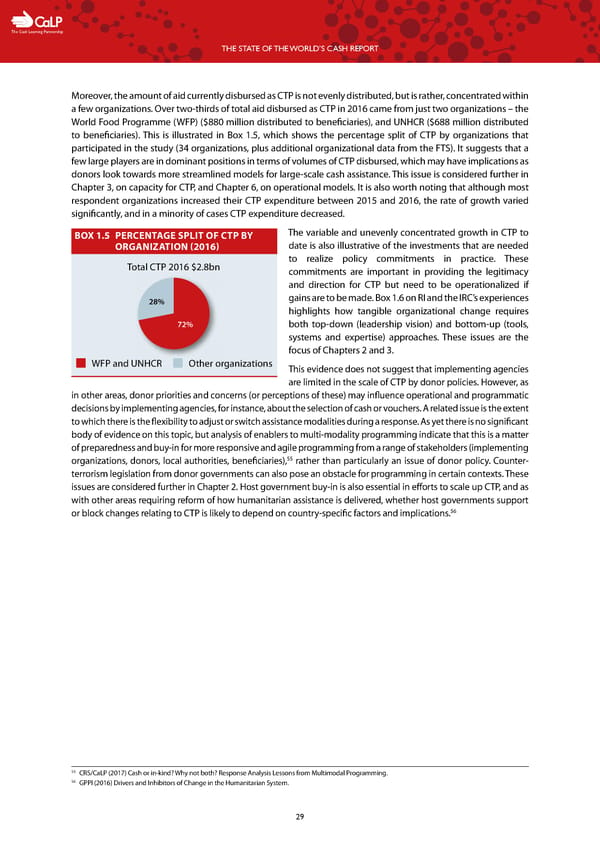C The Cash Learning Partnership THE STATE OF THE WORLD’S CASH REPORT Moreover, the amount of aid currently disbursed as CTP is not evenly distributed, but is rather, concentrated within a few organizations. Over two-thirds of total aid disbursed as CTP in 2016 came from just two organizations – the World Food Programme (WFP) ($880 million distributed to beneficiaries), and UNHCR ($688 million distributed to beneficiaries). This is illustrated in Box 1.5, which shows the percentage split of CTP by organizations that participated in the study (34 organizations, plus additional organizational data from the FTS). It suggests that a few large players are in dominant positions in terms of volumes of CTP disbursed, which may have implications as donors look towards more streamlined models for large-scale cash assistance. This issue is considered further in Chapter 3, on capacity for CTP, and Chapter 6, on operational models. It is also worth noting that although most respondent organizations increased their CTP expenditure between 2015 and 2016, the rate of growth varied significantly, and in a minority of cases CTP expenditure decreased. BOX 1.5 PER CENTAGE SPLIT OF CTP BY The variable and unevenly concentrated growth in CTP to ORGANIZATION (2016) date is also illustrative of the investments that are needed Total CTP 2016 $2.8bn to realize policy commitments in practice. These commitments are important in providing the legitimacy and direction for CTP but need to be operationalized if 28% gains are to be made. Box 1.6 on RI and the IRC’s experiences highlights how tangible organizational change requires 72% both top-down (leadership vision) and bottom-up (tools, systems and expertise) approaches. These issues are the focus of Chapters 2 and 3. WFP and UNHCR Other organizations This evidence does not suggest that implementing agencies are limited in the scale of CTP by donor policies. However, as in other areas, donor priorities and concerns (or perceptions of these) may influence operational and programmatic decisions by implementing agencies, for instance, about the selection of cash or vouchers. A related issue is the extent to which there is the flexibility to adjust or switch assistance modalities during a response. As yet there is no significant body of evidence on this topic, but analysis of enablers to multi-modality programming indicate that this is a matter of preparedness and buy-in for more responsive and agile programming from a range of stakeholders (implementing 55 organizations, donors, local authorities, beneficiaries), rather than particularly an issue of donor policy. Counter- terrorism legislation from donor governments can also pose an obstacle for programming in certain contexts. These issues are considered further in Chapter 2. Host government buy-in is also essential in efforts to scale up CTP, and as with other areas requiring reform of how humanitarian assistance is delivered, whether host governments support or block changes relating to CTP is likely to depend on country-specific factors and implications.56 55 CRS/CaLP (2017) Cash or in-kind? Why not both? Response Analysis Lessons from Multimodal Programming. 56 GPPI (2016) Drivers and Inhibitors of Change in the Humanitarian System. 29
 The State of the World's Cash | Full Report Page 30 Page 32
The State of the World's Cash | Full Report Page 30 Page 32